| |
|
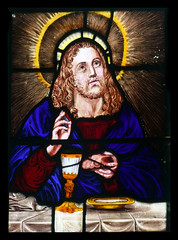 |
|
In the summer of
2016 I decided to try and revisit all the
East Anglian churches I'd not been to
since buying my first digital camera back
in 2003, and Shadingfield was high on my
list. I took the train up to Brampton
station. Brampton is a request stop on
the rambling East Suffolk Line which, in
no particular hurry, joins Ipswich to
Lowestoft through a succession of small
east Suffolk market towns. I think it is
safe to say that Brampton is the most
remote stop on the line, two miles from
the village whose name it takes, and with
just a couple of houses for company. It
is actually much closer to the village of
Redisham, but I'm told that the
Victorians named their stations after the
nearest post office. I was once told by
one of the cheery ticket clerks at
Ipswich station that I was the only
person to whom he'd ever sold a ticket to
Brampton. If you decide to go there
yourself, make sure you don't
accidentally buy a ticket to Brampton in
Cumbria by mistake. Shadingfield is also a
couple of miles from Brampton station,
and it is one of those quiet little
places you often find lost in the lanes
of north-east Suffolk. The energetic
antiquarian David Elisha Davey was a
regular visitor in the 1820s and 1830s,
always spelling it 'Shaddingfield' in his
journals, which remains the modern
pronunciation. The population of the
parish reached a peak of 220 in the 1851
census, of whom almost a half were
attending the church on a Sunday, a
spectacularly high proportion for east
Suffolk.
|
St John the Baptist stands
above the road between Beccles and the A12. The
tower is 15th century, later patched in red-brick
on the north and west sides, which lends it an
endearingly homely quality. Below it on the south
side of the nave is one of those pretty red-brick
porches you frequently find in Suffolk. A Tudor
design of this kind is usually thought of as
being early 16th century, but the image niche is
surprisingly small, and may not even be for
images, and so I wondered if the structure might
actually post-date the Reformation. It conceals
an attractive late 12th Century doorway.
The font stands on a high
platform in the shape of a Maltese cross as at
nearby Weston and, further afield, at Laxfield.
I'm told that baptising babies in these fonts can
be a precipitous affair. The font itself is late
medieval, its panels with shields in quatrefoils
seeming to match those on the base, suggesting
that they were made for each other. The little
heads that peep out from the corners are
delightful. It is probably earlier than the
Weston and Laxfield platforms, both of which
support seven sacrament fonts, so it may have
provided a model for them.
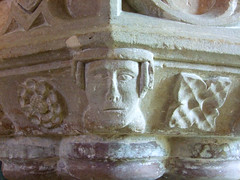 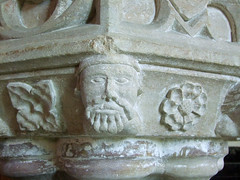 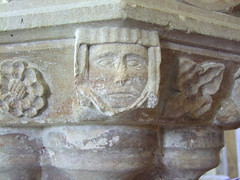
As with many churches in
north-east Suffolk, the unaisled nave and chancel
here run into each other with nothing to mark
their division - or, at least, almost nothing.
For here, although the roodscreen has long gone,
there are two extraordinary corbels set in the
north and south walls, that once supported the
roodloft. The one to the south is formed of a
head, that on the north side of a pair of heads
pressed together, apparently showing us that two
heads are better than one.
The east window contains panels of English and
continental glass. The roundels of the Adoration
of the Shepherds and the very faded Ascension are
both Flemish, I think, but the panel of Christ
blessing bread and wine, probably from an Emmaus
scene, is likely to be English, perhaps by a
local workshop of the early 19th Century. In the
north wall, there is a lancet containing unusual
and beautiful enamelled glass, a memorial to Mary
Kilner who died in 1858, a delicious High
Victorian moment.
There are
fragments of a surviving wall painting
scheme in the nave. That on the north
wall appears to be a Passion sequence -
you can still make out the panel of
Christ being whipped. Elsewhere in the
nave, there's a good set of Charles I
royal arms, and that curiosity of this
part of the county, a banner stave
locker. There are twelve churches in the
Lowestoft area that have them, and their
use appears to be for containing the
wooden poles used to carry images and
crucifixes in medieval processions. Fair
enough - but why only around here? Did
other medieval churches possess wooden
cupboards? So why have none survived?
Perhaps its just a Lowestoft area thing,
the need to tidy bits away.
This parish is famous for the
Shadingfield altar cloth, a rare and
unusual lace-trimmed textile that was
given to the church in 1632. This was at
the time when Archbishop Laud was trying
to reintroduce sacramental practices back
into the Church of England, including the
re-establishment of altars in chancels.
The move fell to the fury of the
puritans; Laud was executed, the altars
were removed, and the pulpit became the
main focus of Anglican worship for the
next 200 years. The altar cloth itself is
now on view in Strangers' Hall Museum in
Norwich. |
|
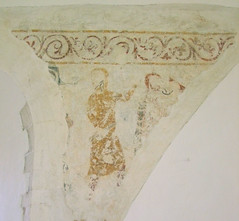 |
|
|
|

